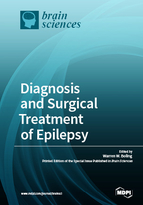Diagnosis and Surgical Treatment of Epilepsy
A special issue of Brain Sciences (ISSN 2076-3425).
Deadline for manuscript submissions: closed (31 January 2018) | Viewed by 71879
Special Issue Editor
Interests: epilepsy; surgery; neurosurgery
Special Issues, Collections and Topics in MDPI journals
Special Issue Information
Dear Colleagues,
Epilepsy is a common neurological disease that can affect all ages. Although the majority of people with epilepsy can have excellent seizure control with medication, about 30% will fail anti-epileptic drugs. For those with medically intractable epilepsy, the recurrent seizures lead to elevated mortality and injury risks and the seizures themselves are socially disabling. Fortunately for many people with intractable epilepsy, epilepsy can be cured or seizures better controlled with surgery.
Localization of the seizure focus followed by surgical resection provides the best opportunity to cure the epilepsy. Better understanding of the neuro-anatomy and physiology of epilepsy improves our ability to define the epileptic network and effectively treat the epilepsy. Minimal access surgical approaches result in more rapid recovery from surgery, less pain, and more satisfied patients.
For individuals without an opportunity for cure of their epilepsy, new and emerging technologies can improve the quality of life by preventing injuries and reducing seizure frequency and severity.
This Special Issue will highlight advances in the diagnosis and surgical treatment of epilepsy, including imaging and electroencephalography (EEG) approaches to define the epileptic focus, understand the epileptic network, and characterize the anatomical substrate of epilepsy.
Dr. Warren W. BolingGuest Editor
Manuscript Submission Information
Manuscripts should be submitted online at www.mdpi.com by registering and logging in to this website. Once you are registered, click here to go to the submission form. Manuscripts can be submitted until the deadline. All submissions that pass pre-check are peer-reviewed. Accepted papers will be published continuously in the journal (as soon as accepted) and will be listed together on the special issue website. Research articles, review articles as well as short communications are invited. For planned papers, a title and short abstract (about 100 words) can be sent to the Editorial Office for announcement on this website.
Submitted manuscripts should not have been published previously, nor be under consideration for publication elsewhere (except conference proceedings papers). All manuscripts are thoroughly refereed through a single-blind peer-review process. A guide for authors and other relevant information for submission of manuscripts is available on the Instructions for Authors page. Brain Sciences is an international peer-reviewed open access monthly journal published by MDPI.
Please visit the Instructions for Authors page before submitting a manuscript. The Article Processing Charge (APC) for publication in this open access journal is 2200 CHF (Swiss Francs). Submitted papers should be well formatted and use good English. Authors may use MDPI's English editing service prior to publication or during author revisions.
Keywords
- Medically Intractable Epilepsy
- EEG
- Epilepsy Surgery
- MRI
- Epilepsy
- Seizures







